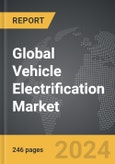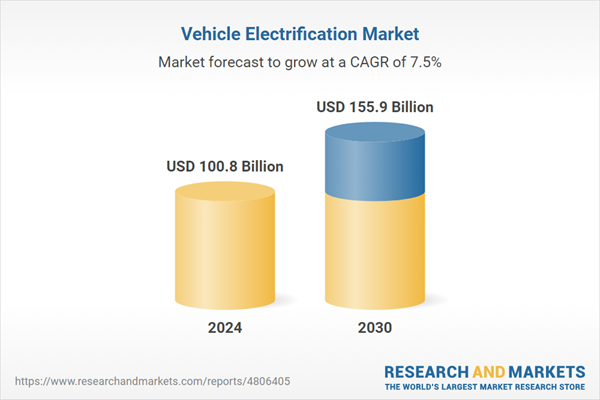The global market for Vehicle Electrification was valued at US$100.8 Billion in 2024 and is projected to reach US$155.9 Billion by 2030, growing at a CAGR of 7.5% from 2024 to 2030. This comprehensive report provides an in-depth analysis of market trends, drivers, and forecasts, helping you make informed business decisions. The report includes the most recent global tariff developments and how they impact the Vehicle Electrification market.
Segments: Product Type (Electric Power Steering, Starter Motors & Alternators, Start / Stop Systems, Actuators, Electric Air Conditioner Compressors, Electric Vacuum Pumps, Liquid Heater PTC, Product Types); Vehicle Type (Internal Combustion Engine (ICE) & Micro-Hybrid Vehicles, Hybrid Electric Vehicles, Other Vehicle Types).
Geographic Regions/Countries: World; United States; Canada; Japan; China; Europe (France; Germany; Italy; United Kingdom; Spain; Russia; and Rest of Europe); Asia-Pacific (Australia; India; South Korea; and Rest of Asia-Pacific); Latin America (Argentina; Brazil; Mexico; and Rest of Latin America); Middle East (Iran; Israel; Saudi Arabia; United Arab Emirates; and Rest of Middle East); and Africa.
The analysts continuously track trade developments worldwide, drawing insights from leading global economists and over 200 industry and policy institutions, including think tanks, trade organizations, and national economic advisory bodies. This intelligence is integrated into forecasting models to provide timely, data-driven analysis of emerging risks and opportunities.
Global Vehicle Electrification Market - Key Trends & Drivers Summarized
Why Is Vehicle Electrification a Major Focus in the Automotive Industry?
Vehicle electrification has become a major focus in the automotive industry as the world transitions towards more sustainable and environmentally friendly transportation solutions. The shift from internal combustion engines (ICEs) to electric powertrains is driven by the need to reduce greenhouse gas emissions, combat climate change, and comply with increasingly stringent emission regulations. Electric vehicles (EVs), including battery electric vehicles (BEVs), plug-in hybrid electric vehicles (PHEVs), and hybrid electric vehicles (HEVs), are at the forefront of this transformation. As governments, consumers, and automakers push for cleaner and more efficient vehicles, the adoption of electrification technologies is accelerating, making vehicle electrification one of the most significant trends in the automotive industry today.How Are Technological Advancements Driving Vehicle Electrification?
Technological advancements are playing a critical role in driving the adoption and development of vehicle electrification. Improvements in battery technology, particularly in lithium-ion batteries, have significantly increased the range, efficiency, and affordability of electric vehicles. The development of fast-charging infrastructure and wireless charging systems is also enhancing the convenience and practicality of owning an EV, addressing one of the key barriers to widespread adoption. Additionally, advancements in power electronics, electric motors, and energy management systems are improving the performance, reliability, and safety of electric powertrains. These innovations are not only making electric vehicles more competitive with traditional ICE vehicles but also opening up new possibilities for electrification in other types of vehicles, such as trucks, buses, and two-wheelers. The continuous evolution of these technologies is driving the rapid growth of the vehicle electrification market.What Are the Emerging Trends in Vehicle Electrification?
The vehicle electrification market is witnessing several emerging trends that are shaping its future. One significant trend is the increasing focus on developing more efficient and sustainable battery technologies, including solid-state batteries and battery recycling solutions, to address concerns about resource scarcity and environmental impact. Another trend is the growing interest in electrification of commercial vehicles, such as electric trucks and buses, as fleet operators seek to reduce operational costs and meet regulatory requirements. The market is also seeing a rise in the development of electric vehicle platforms, which are specifically designed for EVs and offer greater design flexibility, improved aerodynamics, and better integration of batteries and electric components. Additionally, the emergence of vehicle-to-grid (V2G) technology, which allows EVs to supply power back to the grid, is creating new opportunities for energy management and grid stabilization, further driving the adoption of vehicle electrification.What Factors Are Driving the Growth of the Vehicle Electrification Market?
The growth in the vehicle electrification market is driven by several factors, including the increasing demand for cleaner and more sustainable transportation solutions, which is fueled by growing environmental concerns and the need to reduce carbon emissions. The stringent emission regulations imposed by governments worldwide are also a major driver, as they compel automakers to adopt electrification technologies to comply with these standards. Additionally, the continuous advancements in battery technology, charging infrastructure, and electric powertrain components are making electric vehicles more accessible, affordable, and appealing to consumers. The rising fuel prices and the desire for energy independence are further boosting demand for electric vehicles, as they offer lower operating costs and reduced reliance on fossil fuels. Moreover, the increasing investments in EV production and infrastructure by automakers, governments, and private companies are accelerating the market's growth, as they enhance the availability and viability of electric vehicles on a global scale.Report Scope
The report analyzes the Vehicle Electrification market, presented in terms of units. The analysis covers the key segments and geographic regions outlined below.Segments: Product Type (Electric Power Steering, Starter Motors & Alternators, Start / Stop Systems, Actuators, Electric Air Conditioner Compressors, Electric Vacuum Pumps, Liquid Heater PTC, Product Types); Vehicle Type (Internal Combustion Engine (ICE) & Micro-Hybrid Vehicles, Hybrid Electric Vehicles, Other Vehicle Types).
Geographic Regions/Countries: World; United States; Canada; Japan; China; Europe (France; Germany; Italy; United Kingdom; Spain; Russia; and Rest of Europe); Asia-Pacific (Australia; India; South Korea; and Rest of Asia-Pacific); Latin America (Argentina; Brazil; Mexico; and Rest of Latin America); Middle East (Iran; Israel; Saudi Arabia; United Arab Emirates; and Rest of Middle East); and Africa.
Key Insights:
- Market Growth: Understand the significant growth trajectory of the Electric Power Steering segment, which is expected to reach US$48.5 Billion by 2030 with a CAGR of a 9.0%. The Starter Motors & Alternators segment is also set to grow at 6.6% CAGR over the analysis period.
- Regional Analysis: Gain insights into the U.S. market, valued at $26.2 Billion in 2024, and China, forecasted to grow at an impressive 12.4% CAGR to reach $39.7 Billion by 2030. Discover growth trends in other key regions, including Japan, Canada, Germany, and the Asia-Pacific.
Why You Should Buy This Report:
- Detailed Market Analysis: Access a thorough analysis of the Global Vehicle Electrification Market, covering all major geographic regions and market segments.
- Competitive Insights: Get an overview of the competitive landscape, including the market presence of major players across different geographies.
- Future Trends and Drivers: Understand the key trends and drivers shaping the future of the Global Vehicle Electrification Market.
- Actionable Insights: Benefit from actionable insights that can help you identify new revenue opportunities and make strategic business decisions.
Key Questions Answered:
- How is the Global Vehicle Electrification Market expected to evolve by 2030?
- What are the main drivers and restraints affecting the market?
- Which market segments will grow the most over the forecast period?
- How will market shares for different regions and segments change by 2030?
- Who are the leading players in the market, and what are their prospects?
Report Features:
- Comprehensive Market Data: Independent analysis of annual sales and market forecasts in US$ Million from 2024 to 2030.
- In-Depth Regional Analysis: Detailed insights into key markets, including the U.S., China, Japan, Canada, Europe, Asia-Pacific, Latin America, Middle East, and Africa.
- Company Profiles: Coverage of players such as Aisin Seiki Co., Ltd., Aptiv PLC, BorgWarner, Inc., Continental AG, Denso Corporation and more.
- Complimentary Updates: Receive free report updates for one year to keep you informed of the latest market developments.
Some of the 46 companies featured in this Vehicle Electrification market report include:
- Aisin Seiki Co., Ltd.
- Aptiv PLC
- BorgWarner, Inc.
- Continental AG
- Denso Corporation
- Hitachi Automotive Systems Ltd.
- Johnson Controls, Inc.
- Johnson Electric Holdings Ltd.
- JTEKT Corporation
- Magna International, Inc.
- Mitsubishi Electric Corporation
- Robert Bosch GmbH
- Valeo SA
- WABCO Holdings Inc.
- ZF Friedrichshafen AG
Tariff Impact Analysis: Key Insights for 2025
Global tariff negotiations across 180+ countries are reshaping supply chains, costs, and competitiveness. This report reflects the latest developments as of April 2025 and incorporates forward-looking insights into the market outlook.The analysts continuously track trade developments worldwide, drawing insights from leading global economists and over 200 industry and policy institutions, including think tanks, trade organizations, and national economic advisory bodies. This intelligence is integrated into forecasting models to provide timely, data-driven analysis of emerging risks and opportunities.
What’s Included in This Edition:
- Tariff-adjusted market forecasts by region and segment
- Analysis of cost and supply chain implications by sourcing and trade exposure
- Strategic insights into geographic shifts
Buyers receive a free July 2025 update with:
- Finalized tariff impacts and new trade agreement effects
- Updated projections reflecting global sourcing and cost shifts
- Expanded country-specific coverage across the industry
Table of Contents
I. METHODOLOGYII. EXECUTIVE SUMMARY2. FOCUS ON SELECT PLAYERSIII. MARKET ANALYSISCANADAITALYSPAINRUSSIAREST OF EUROPESOUTH KOREAREST OF ASIA-PACIFICARGENTINABRAZILMEXICOREST OF LATIN AMERICAIRANISRAELSAUDI ARABIAUNITED ARAB EMIRATESREST OF MIDDLE EASTIV. COMPETITION
1. MARKET OVERVIEW
3. MARKET TRENDS & DRIVERS
4. GLOBAL MARKET PERSPECTIVE
UNITED STATES
JAPAN
CHINA
EUROPE
FRANCE
GERMANY
UNITED KINGDOM
ASIA-PACIFIC
AUSTRALIA
INDIA
LATIN AMERICA
MIDDLE EAST
AFRICA
Companies Mentioned (Partial List)
A selection of companies mentioned in this report includes, but is not limited to:
- Aisin Seiki Co., Ltd.
- Aptiv PLC
- BorgWarner, Inc.
- Continental AG
- Denso Corporation
- Hitachi Automotive Systems Ltd.
- Johnson Controls, Inc.
- Johnson Electric Holdings Ltd.
- JTEKT Corporation
- Magna International, Inc.
- Mitsubishi Electric Corporation
- Robert Bosch GmbH
- Valeo SA
- WABCO Holdings Inc.
- ZF Friedrichshafen AG
Table Information
| Report Attribute | Details |
|---|---|
| No. of Pages | 246 |
| Published | April 2025 |
| Forecast Period | 2024 - 2030 |
| Estimated Market Value ( USD | $ 100.8 Billion |
| Forecasted Market Value ( USD | $ 155.9 Billion |
| Compound Annual Growth Rate | 7.5% |
| Regions Covered | Global |









